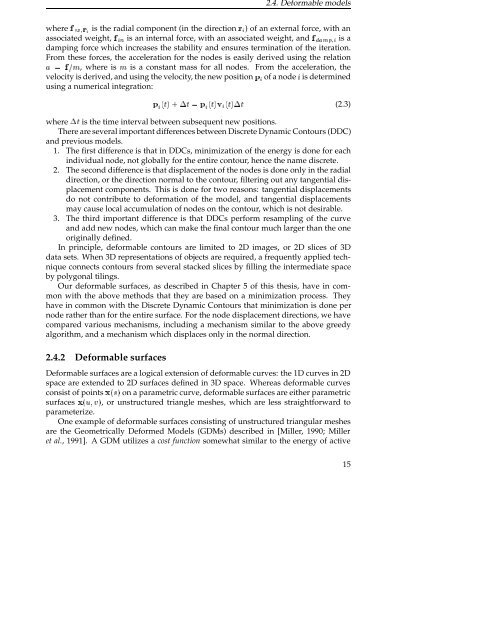Chapter 4 Vortex detection - Computer Graphics and Visualization
Chapter 4 Vortex detection - Computer Graphics and Visualization
Chapter 4 Vortex detection - Computer Graphics and Visualization
Create successful ePaper yourself
Turn your PDF publications into a flip-book with our unique Google optimized e-Paper software.
2.4. Deformable models<br />
where ÜÖ is the radial component (in the direction Ö) of an external force, with an<br />
associated weight, Ò is an internal force, with an associated weight, <strong>and</strong> ÑÔ is a<br />
damping force which increases the stability <strong>and</strong> ensures termination of the iteration.<br />
From these forces, the acceleration for the nodes is easily derived using the relation<br />
Ñ, where is Ñ is a constant mass for all nodes. From the acceleration, the<br />
velocity is derived, <strong>and</strong> using the velocity, the new position Ô of a node is determined<br />
using a numerical integration:<br />
Ô Ø ¡Ø Ô Ø Ú Ø ¡Ø (2.3)<br />
where ¡Ø is the time interval between subsequent new positions.<br />
There are several important differences between Discrete Dynamic Contours (DDC)<br />
<strong>and</strong> previous models.<br />
1. The first difference is that in DDCs, minimization of the energy is done for each<br />
individual node, not globally for the entire contour, hence the name discrete.<br />
2. The second difference is that displacement of the nodes is done only in the radial<br />
direction, or the direction normal to the contour, filtering out any tangential displacement<br />
components. This is done for two reasons: tangential displacements<br />
do not contribute to deformation of the model, <strong>and</strong> tangential displacements<br />
may cause local accumulation of nodes on the contour, which is not desirable.<br />
3. The third important difference is that DDCs perform resampling of the curve<br />
<strong>and</strong> add new nodes, which can make the final contour much larger than the one<br />
originally defined.<br />
In principle, deformable contours are limited to 2D images, or 2D slices of 3D<br />
data sets. When 3D representations of objects are required, a frequently applied technique<br />
connects contours from several stacked slices by filling the intermediate space<br />
by polygonal tilings.<br />
Our deformable surfaces, as described in <strong>Chapter</strong> 5 of this thesis, have in common<br />
with the above methods that they are based on a minimization process. They<br />
have in common with the Discrete Dynamic Contours that minimization is done per<br />
node rather than for the entire surface. For the node displacement directions, we have<br />
compared various mechanisms, including a mechanism similar to the above greedy<br />
algorithm, <strong>and</strong> a mechanism which displaces only in the normal direction.<br />
2.4.2 Deformable surfaces<br />
Deformable surfaces are a logical extension of deformable curves: the 1D curves in 2D<br />
space are extended to 2D surfaces defined in 3D space. Whereas deformable curves<br />
consist of points Ü × on a parametric curve, deformable surfaces are either parametric<br />
surfaces Ü Ù Ú , or unstructured triangle meshes, which are less straightforward to<br />
parameterize.<br />
One example of deformable surfaces consisting of unstructured triangular meshes<br />
are the Geometrically Deformed Models (GDMs) described in [Miller, 1990; Miller<br />
et al., 1991]. A GDM utilizes a cost function somewhat similar to the energy of active<br />
15

















